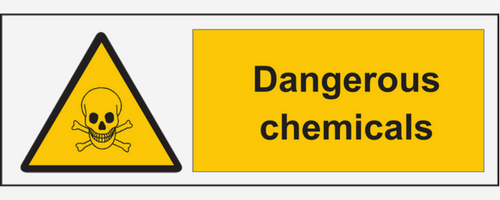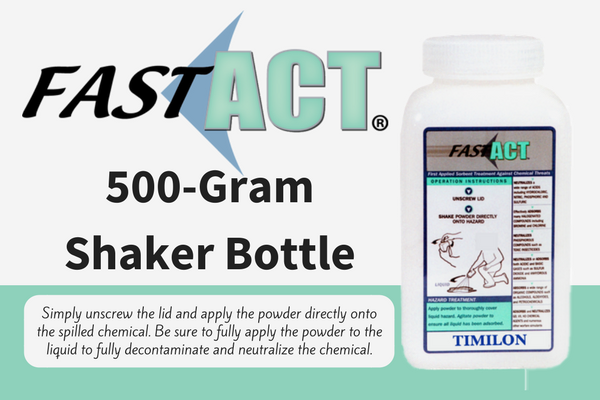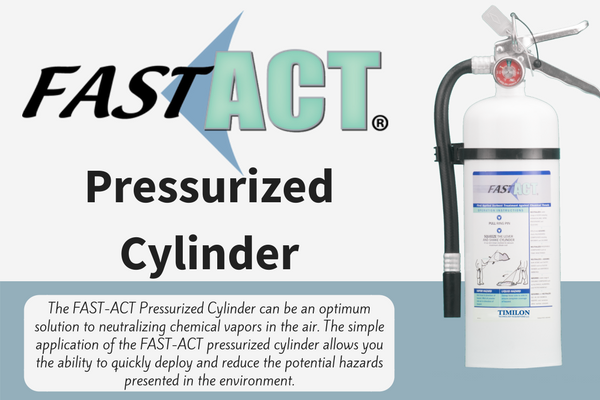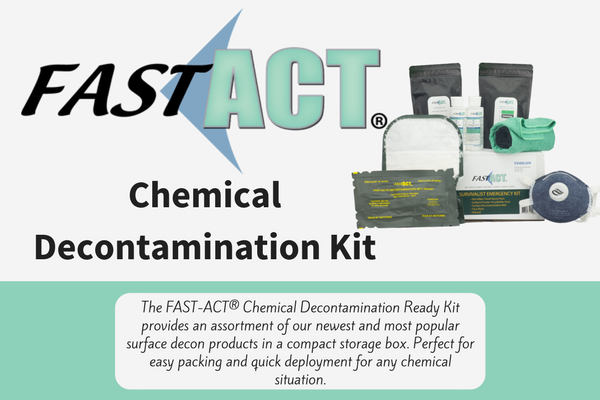Chemicals are everywhere, and in insurmountable numbers even if you are not aware of it. Chemicals can be used in a variety of applications as well as helping to keep our food fresh to even cleaning our bodies. Under certain conditions, chemicals can be useful but in others, they can present hazardous and harmful effects to our health. Some chemicals that are even safe to use in normal circumstances, can become hazardous in large quantities. Preparing for potentially hazardous situations is something we do almost every day, from putting our seatbelt on to protect ourselves, having a fire extinguisher in our home in case of a fire, or even having a first-aid kit available when an injury occurs in your home. So why wouldn’t you want to be prepared for a chemical exposure in your environment as well?
What Types of Chemicals are Hazardous
Determining the level of hazard presented by each type of chemical will depend on a variety of different aspects, such as the composition of the chemical and the amount of which is present in the environment. Some of the most well-known and classified hazardous groups of chemicals include Anticholinergic Agents, Biotoxins, Caustics, Choking Agents, Blistering Agents, and Nerve Agents. You may have never heard of these chemical groups before, but the chemicals contained in these groups will refresh your mind.
- Mustard gas
- Chlorine
- Sarin
- Tabun
- Soman
- Lewisite
- VX
- Acids
- Bases
- Organics
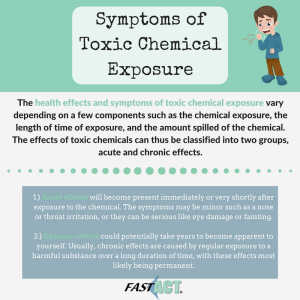 Symptoms of Toxic Chemical Exposure
Symptoms of Toxic Chemical Exposure
Chemicals can enter the body through the three main “routes of exposure”, including inhalation, skin or eye contact, and ingestion.
- Inhalation is the act of breathing in chemical hazards whether the chemical is a gas, mist, or dust that is in the air.
- Skin & Eye Contact occurs when chemicals make contact with your eyes or skin they can damage the skin and even be absorbed through the skin and find its way into your bloodstream.
- Ingestion of chemicals can happen when the chemicals spill or settle onto your drink, food, beard, or hands.
The health effects and symptoms of toxic chemical exposure vary depending on a few components such as the chemical exposure, the length of time of exposure, and the amount spilled of the chemical. The effects of toxic chemicals can thus be classified into two groups, acute and chronic effects.
- Acute effects will become present immediately or very shortly after exposure to the chemical. The symptoms may be minor such as a nose or throat irritation, or they can be serious like eye damage or fainting.
- Chronic effects could potentially take years to become apparent to yourself. Usually, chronic effects are caused by regular exposure to a harmful substance over a long duration of time, with these effects most likely being permanent.
The Different Types of Chemical Exposures
When you are surrounded by or in the presence of chemicals, the possibility of an exposure occurring is plausible. Chemicals in the workplace, in your home, in a laboratory, or even in potential threat situation can present hazards to those exposed to the chemical.
Laboratory Chemical Scenarios
Laboratories are one of the main environments that could be exposed to chemicals and hazards. With over hundreds of different chemicals in their facility, the risk factors and dangers are drastic. Due to the nature of this environment and the processes that are undertaken in this atmosphere, planning and being prepared for potential chemical exposures and spills is vital. The first steps in a laboratory are to have employee and personnel have a basic understanding of the risks and precautions involved with dealing with chemicals. Also, having a plan to implement when a chemical exposure occurs and placing chemical decontamination equipment in an accessible area is critical. Chemical spills are the most common form of chemical exposure in this environment, thus having a fast-acting chemical decontamination application to deploy on the infected area is a necessary step to take. The FAST-ACT 500-gram Shaker Bottle provides you a fast and easy solution to liquid chemical spills in your environment. Simply unscrew the lid and apply the powder directly onto the spilled chemical. Be sure to fully apply the powder on the liquid chemical to fully decontaminate and neutralize the chemical.
 Hazmat Exercise Chemical Scenarios
Hazmat Exercise Chemical Scenarios
The United States National Response Team has conducted training to a composed group of 15 federal agencies that have major responsibilities in environmental, transportation, emergency management, worker safety, and public health areas. The U.S. National Response Team is responsible for coordinating federal planning, preparedness, and response actions related to oil discharges and hazardous substance releases in the environment such as weapons of mass destruction and other environmental incidents. During these training scenarios, they go over response mechanisms and make recommendations regarding the improvement of the response system. When discussing response steps to take for chemical scenarios for hazmat exercises a potential resource that can be used is the FAST-ACT technology that is effective at quickly deploying and neutralizing chemical hazards in the environment. FAST-ACT utilizes a proprietary formulation that is effective at neutralizing a wide range of chemicals, with the added capability to destroy chemical warfare agents that are extremely hazardous chemicals. When dealing with a chemical warfare agent, deploying the FAST-ACT Pressurized Cylinder can be an optimum solution to neutralizing chemical vapors in the air. The simple application of the FAST-ACT pressurized cylinder allows you the ability to quickly deploy and reduce the potential hazards presented in the environment.
 Terrorist Attack Chemical Scenarios
Terrorist Attack Chemical Scenarios
The potential possibility of a terrorist attack occurring in the United States is no longer an empty threat but a possible scary reality. And with the use of chemical or biological weapons of mass destruction being the source of the attack, learning how to prepare for these attacks is critical. The United States has taken serious steps in preparing for terrorist attacks using these weapons and even went as far as to enact the Defense Against Weapons of Mass Destruction Act in 1996. Although it is a positive step to know that your state has in place a plan of protection in this circumstance, you still want to have personal protection on hand that you can use in the event that this type of chemical scenario is present in your environment. The FAST-ACT Chemical Decontamination Kit provides an assortment of surface decontamination products that can be used in an emergency situation. Whether you are dealing with a liquid chemical or vapor chemical release, the FAST-ACT Chemical Decontamination Kit can arm you with chemical protection. The kit includes the following products:
- FAST-ACT Decon Mitt (4 Mitts)
- FAST-ACT Sorbent Powder Bottle Set
- FAST-ACT Microfiber Towel Set
- FAST-ACT/ VapourKlenz Face Masks (3)
- User Manual and Product Information


